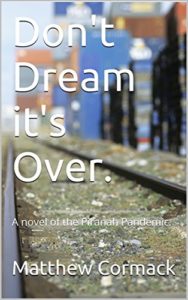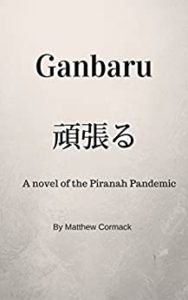Matthew Cormack
My favorite form of the post-apocalyptic novel is the cozy catastrophe.
My introduction to this sub-sub-genre was with the classic novel Earth Abides by George R Stewart.
That introduction was 30+ years ago, and I immediately fell in love with the book. But at the time I was unaware that there were others like it. Because back then there was no internet and easy information.
Years later, I learned that Earth Abides was merely one example of an entire sub-genre of post-apocalyptic fiction called cozy catastrophes. And boy was I happy!
In my opinion, Matthew Cormack is the cozy catastrophe writer par excellence. His Piranha Pandemic universe is an awful place, but one filled with hope that a better world will eventually rise up and replace the one that died.
To date, there are 3 novels set in his post-apocalyptic world:
The Piranha Pandemic: From Small Acorns…
All three are superlative examples of the cozy catastrophe. They portray with stunning realism the collapse of society, and how people will react to the loss of everything. And in true cozy catastrophe fashion, he shows how people will try to re-organize and rebuild society.
The books are standalone, so you can read them in any order.
Don’t Dream It’s Over was the first book published. It’s the story of one survivor of the apocalypse. It is the best novel in epistolary form that I’ve read. It is also one of the best in-depth character studies I’ve read. The book, quite simply, is brilliant.
Ganbaru is the story of what happens when a small peace-oriented community comes into contact with an aggressive and belligerent group. The results aren’t pretty, to say the least. An exciting novel that will keep you on the edge of your chair.
The Piranha Pandemic: From Small Acorns… is a prequel novel, as it tells how the pandemic came about and describes, with horrifying realism, the collapse of civilization.
As the origin of the pandemic is hinted at in Don’t Dream It’s Over, I suggest you read the books in the order above. You’ll see the state of things after the collapse from two perspectives, and then read about the collapse as it happened.
As a writer, Mr Cormack is a master craftsman. He knows how to tell an exciting story. He knows how to create believable and realistic people. His world is well-thought out and hangs together.
I can’t say enough good things about this “Sunday writer”, as he refers to himself. All I can say is that I wish every day was Sunday.
Treat yourself to the best cozy catastrophes being written today. Heck, the best post-apocalyptic fiction being written today. This Indie April acquaint yourself with Matthew Cormack. You’ll be glad you did.
Comments are always welcome! And until next time, happy reading!
Share This!


